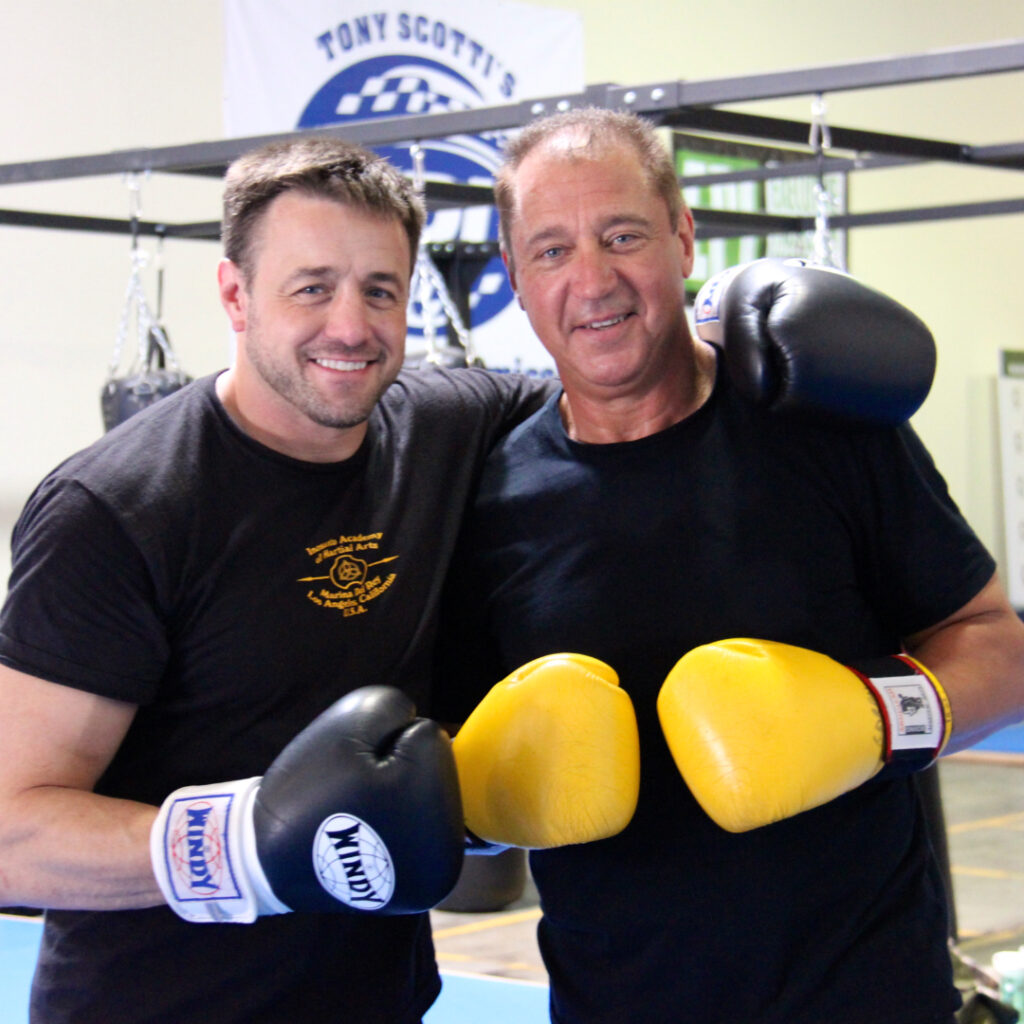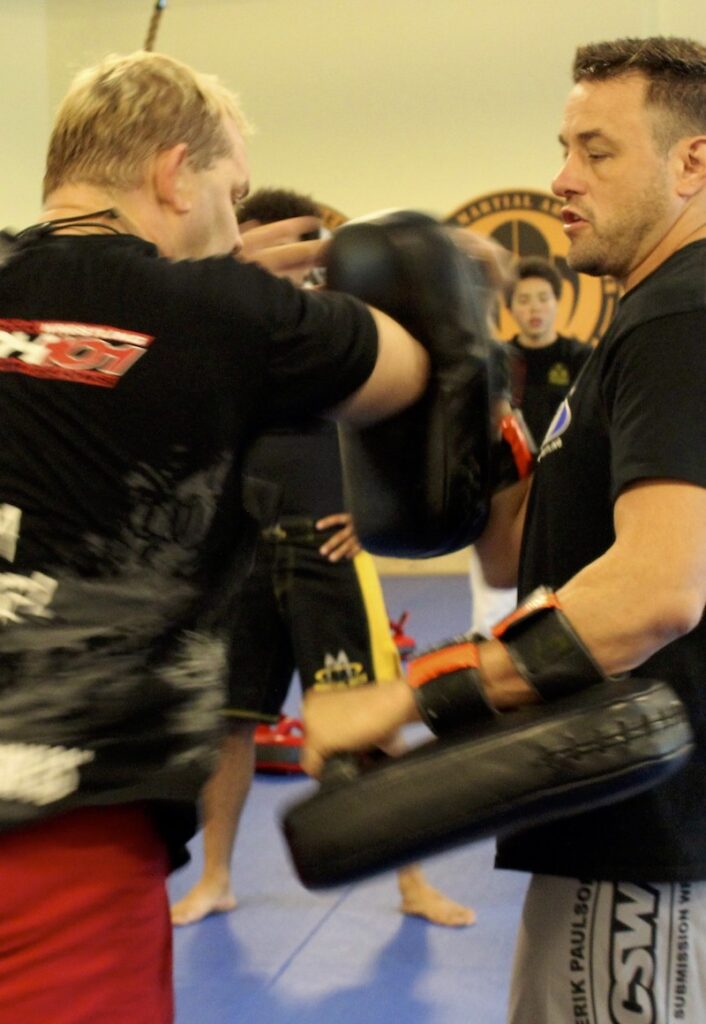
The AMAC Kickboxing program is designed for the busy adult looking to improve their physical conditioning and their cardiovascular fitness as they learn one of the most powerful striking arts in the world.
In the basic program sparring/fighting with other students is optional, so you don’t have to worry about getting injured as you train. In every class, we strive to create a high-energy and safe class environment in which you can participate. It is our goal to assist you on your goal of self improvement and a high level martial education at every level. Proper and consistent Kickboxing training will produce a healthy and strong body.
Kickboxing workouts allow you to burn out 350 to 500 calories or more in just an hour. It also helps maintaining the heart rate at 75 percent to 85 percent regular beat. This has been proven to be good and is the recommended range if you are exercising or into training. The class environment will also develop higher levels of personal discipline, determination, self‐confidence and focus.
This Class is a blend of martial arts systems curated by legends such as Coach Erik Paulson, Guro Dan Inosanto, and Arjan Chai Sirisute. Our program integrates the best elements of STX Kickboxing, Jun Fan Kickboxing, and Thai Boxing.
In our AMAC Kickboxing program, practitioners delve into a diverse array of striking techniques, drawing from the explosive arsenal of Boxing, Panantukan, Jun Fan/JKD Kickboxing, Savate, and Muay Thai. From powerful elbows and punches to precise kicks, knees, and traditional Muay Thai strikes, students learn a versatile range of techniques applicable in various combat scenarios.
Central to our philosophy is the emphasis on adaptability and versatility, enabling practitioners to transition seamlessly between different striking styles and techniques. Through structured training sessions encompassing glove drills, focus mitt work, Thai pad training, and live sparring, students develop skills and confidence essential for excelling in MMA, kickboxing, and self-defense.
Our program caters to practitioners of all levels, from beginners seeking effective self-defense techniques to seasoned martial artists honing their striking game. With a focus on practicality and real-world applicability, AMAC Kickboxing empowers students to become well-rounded and proficient strikers.
Join us to experience the perfect blend of STX Kickboxing, Jun Fan Kickboxing, and Thai Boxing.
________________
Jun Fan Kickboxing
Jun Fan Kickboxing, also known as Jeet Kune Do Kickboxing, is a dynamic and versatile martial arts discipline that encompasses the principles of Bruce Lee’s Jeet Kune Do philosophy fused with traditional kickboxing techniques. Developed by Bruce Lee himself, Jun Fan Kickboxing emphasizes efficiency, directness, and simplicity in combat.
At its core, Jun Fan Kickboxing is characterized by its fluidity and adaptability, allowing practitioners to seamlessly transition between various striking techniques, including punches, kicks, elbows, and knees. Unlike some traditional martial arts styles, Jun Fan Kickboxing does not adhere to rigid forms or patterns, but rather encourages practitioners to explore and develop their own personal expression of combat.
One of the key principles of Jun Fan Kickboxing is interception, where practitioners aim to intercept and counter their opponent’s attacks with precise and well-timed strikes. This concept is closely tied to Bruce Lee’s famous phrase, “Using no way as way, having no limitation as limitation,” which emphasizes the importance of adapting to the ever-changing dynamics of a fight.
In addition to its emphasis on striking, Jun Fan Kickboxing also incorporates elements of trapping and grappling, allowing practitioners to seamlessly transition between different ranges of combat. This holistic approach to fighting makes Jun Fan Kickboxing effective in a variety of situations, whether it be in the ring, on the street, or in self-defense scenarios.
Overall, Jun Fan Kickboxing is not just a martial art, but a philosophy that encourages practitioners to continuously evolve and adapt their skills to become more effective fighters. With its emphasis on simplicity, efficiency, and adaptability, Jun Fan Kickboxing remains a potent and practical martial art for practitioners of all levels.
___________
STX Kickboxing
Welcome to the STX Kickboxing program, meticulously crafted by renowned mixed martial artist and coach Erik Paulson. STX Kickboxing is not just another martial arts system; it’s a dynamic hybrid striking system that seamlessly integrates the explosive techniques of Boxing, Panantukan, Jun Fan/JKD Kickboxing, Savate, and Muay Thai (drawing from both Thai and Dutch methods).
In our STX Kickboxing program, students dive into a comprehensive curriculum that blends the best elements from each of these martial arts disciplines. From powerful elbows to crisp punches and devastating knees, practitioners learn a diverse array of striking techniques that are essential for success in MMA, kickboxing, and self-defense scenarios.
Our training approach encompasses a variety of tools and methods to ensure students develop a well-rounded skill set. Through glove drills, focus mitt work, Thai pad training, and live sparring sessions, students have the opportunity to refine their techniques and gain practical experience in applying them in realistic situations.
STX Kickboxing isn’t just about mastering individual techniques; it’s about understanding how to seamlessly transition between different striking styles and adapt to the ever-changing dynamics of a fight. Whether you’re a seasoned martial artist looking to elevate your striking game or a beginner seeking to learn effective self-defense techniques, our STX Kickboxing program offers a dynamic and engaging training experience for practitioners of all levels.
Join us on the journey to mastering the art of STX Kickboxing and unlock your full potential as a striker.
Muay Thai Boxing
Muay Thai is referred to as the science of 8 limbs, so Lethwei can be called the science of 9 limbs, due to the allowance of head butts. In comparison, Lethwei can be interpreted as being bolder and more extreme. The techniques are a bit slower and stronger than in the other Southeast Asian kickboxing forms, possibly because it has more Indian influence than the other styles. Fights are traditionally held outdoors in sandpits instead of rings, but in modern times they are now held in rings. Popular techniques in Lethwei include leg kicks, knees, elbows, head butts, raking knuckle strikes, and take downs.
Muay Thai literally Thai Boxing and also known as The Art of the Eight Limbs is the Thai name for a form of hard martial arts practiced in several Southeast Asian countries including Thailand. It is known as Pradal Serey in Cambodia, Tomoi in Malaysia, Muay Lao in Laos and as a similar style called Lethwei in Myanmar. The different styles of kickboxing in Southeast Asia are analogous to the different types of Kung Fu in China or Silat in the Malay peninsula.
Muay Thai has a long history in Thailand and is the country’s national sport. Traditional Muay Thai practiced today varies slightly from the ancient art Muay Boran and uses kicks and punches in a ring with gloves similar to those used in Western boxing. Muay Thai is referred to as “The Science of Eight Limbs”, as the hands, shins, elbows, and knees are all used extensively in this art. A master practitioner of Muay Thai thus has the ability to execute strikes using eight “points of contact,” as opposed to “two points” (fists) in Western boxing and “four points” (fists, feet) used in the primarily sport‐oriented forms of martial arts.

Ultimately, as a martial artist it is about getting better, continually striving to be the best that you can be. To do that you have to be under watchful eyes of those that have spent years training, honing their skills, learning different training methods, better ways to teach, investing in their craft going to seminars, doing private lessons, actually going to places like Thailand, Brazil, Holland… to learn everything they can about the art(s) they are teaching… and lastly, they are always honing their own skills and learning how to pass on and share their vast knowledge.
Greg Nelson
